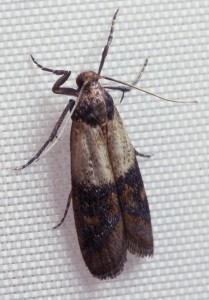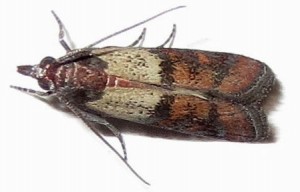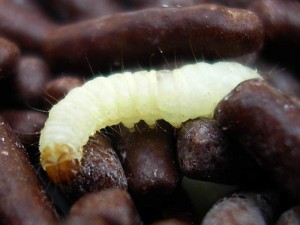We recommend flour moth traps for the prevention and control of bicolor seed moths:
Facts about two-colored seed moths
Occurrence: Two-colored seed moths (Plodia interpunctella) originated in South America, but are now found almost all over the globe and are especially a problem in warmer countries. In Denmark, they are less common than clothes moth and fur mothand as common as seed moth.
FoodThe two-colored seed moth larvae are the real pests. They can feed on a wide range of vegetable materials, but in households and storage facilities they mainly attack breakfast cereals, bread, grains, pasta, rice, raisins, flour, spices, nuts, dried fruits, etc. They are sometimes also found in chocolate, cocoa, instant coffee, etc.
CombatEffective control of the two-colored seed moth is largely about removing their eggs and larvae, as well as their growth opportunities. The best way to do this is by cleaning their habitats - i.e. cupboards and shelves in the kitchen - and storing all dry food in tightly sealed containers. Read more about control below.
Fighting two-colored seed moths
Below is a step-by-step guide to controlling two-colored seed moths in the home - but remember that persistent or recurring problems with two-colored seed moths can be caused by infestations in your food store (supermarket, greengrocer, etc.) and that the fight should also take place there!
- Move all food out of the cabinets/shelves and check them for infestation
- Discard all infested food and throw the garbage bag in your dumpster
- Clean all cabinets/shelves thoroughly:
- Start by vacuuming them, paying special attention to edges, corners, cracks, crevices, holes, etc.
- Wipe with a cloth dampened with ordinary stock vinegar mixed with a little organic peppermint oil or tea tree oil (vinegar and essential oil in combination is very effective against bicolor seed moths) - do not use water!
- In the future, store all food in tightly sealed containers (not plastic bags)
- Place a few bay leaves in each cupboard/shelf (bay leaves have a deterrent effect on bicolored seed moths)
- Set up flour moth traps:
Note that the method described above is simply a combination of good hygiene and home remedies, but it is effective, environmentally friendly and safe for health as well as food.
Also remember to never use water to clean moth infestations, as some species are highly dependent on moisture and therefore thrive even better if you moisturize their habitats.
In the case of heavy or recurring infestations, it may be necessary to dismantle kitchen elements such as cabinets, white goods, hoods, etc. in order to examine the areas behind the elements for moth larvae and eggs. If they are found here, they should of course be removed, and the areas should be cleaned by vacuuming and possibly also with a cloth as described above.
Preventing future attacks
Preventing future infestations is very much about hygiene - i.e:
-
- Store all food in tightly sealed containers (not plastic bags)
- Regularly clean cabinets and shelves according to the instructions above
- Regularly sort food in your kitchen cabinets
- Discard all food that has passed its expiration date
- Place bay leaves next to the food
- Buy only small amounts of dry food at a time
- Set up flour moth traps:
The first point above - food storage - is very important because two-colored moth caterpillars can eat through plastic bags (even very thin plastic containers), paper, cardboard and textiles. They are also capable of crawling through knotted bag openings as well as up glass containers and into loosely screwed lids.
When buying dry foods, you can choose to freeze them for a week immediately after purchase, which kills any eggs. However, not all dried foods can withstand freezing.
It should also be kept in mind that in some cases, moth eggs and larvae come directly from local food retailers (or an earlier stage of production or distribution) and in these cases they should be made aware of the problem.
Insecticides
There are various moth repellents available to control seed moths, including moth traps, moth capsules and moth hangers. What these products have in common is that they release pheromones that attract the moths.
However, most moth repellents are not very effective because they only attract and kill adult male moths; in other words, they don't remove the cause of the problem (i.e. the eggs and larvae as well as the female moths), but only the superficial symptom of the problem.
Many moth repellents are also not suitable for use near food - where the two-colored seed moths live. However, moth traps can be useful for monitoring the extent and development of a moth infestation. They usually last 4-6 weeks.
In addition, there are also insecticides that are suitable for killing insects "as a whole". We advise against using this type of insecticide for all types of moth infestation - read more about this in our article on moth sprays.
Signs of moth infestation
When moth infested foods are detected in Denmark, it is usually due to bicolored seed moths. Infestation typically occurs in dry foods such as breakfast cereals, bread, grains, beans, lentils, bulgur, pasta, rice, raisins, flour, spices, nuts, dried fruits, semolina, etc. but can also occur in chocolate, cocoa, instant coffee, etc.
The telltale signs of an infestation are:
- Food & Beverage: Food that is infested with larvae may contain webs (like spider webs), be lumpy or soiled by the larvae's feces.
- LarvaeNewly hatched larvae are very small and difficult to spot, but as adults they are visible (if you can find them!). The adult larvae can sometimes be seen in or around food. In the latter case, they will often try to hide in dark corners, crevices, etc. They are yellowish or whitish and have dark brown heads. When fully developed, they measure 12-13 mm. Read more about moth larvae here.
- Adult moths: Of course, if adult moths are flying or crawling around, this is an obvious sign of the moths' presence. By looking at a moth, you can quickly determine whether it is a bicolor moth or another moth species (bicolored moths are 0.8 - 1 cm long with a wingspan of 1.6 - 2 cm. The front third of their wings are light gray, while the bottom half is reddish brown). All adult moths should be killed immediately.
In larger commercial warehouses (grain stores, etc.), the two-colored seed moths can be a big problembecause they can destroy large amounts of food in a short period of time.
Two-colored frog moth larvae have white bodies and dark brown heads. As hatchlings they are difficult to spot, but later on they can be seen.
Disposal of food
Whether or not to discard infested food is a matter of assessing the extent of the infestation:
- If the damage to the food is very minor, you can simply heat the food to +60 degrees (e.g. in the oven) for 1 hour or deep-freeze it for 2 days in a freezer at -18 degrees or lower temperatures.
- If the food has a lot of visible damage, it should be discarded - remember to take the waste out as soon as possible.
Description of the two-colored seed moth
An adult bicolor seed moth is 0.8 - 1 cm long and has a wingspan of 1.6 - 2 cm.
The front third of their wings are light gray, while the lower part is coppery red. This division of wing colors has given the moths their name and also makes it easy to distinguish the two-colored seed moths from other moths.
The adult moths mostly fly around at night and are attracted to light.

Life cycle
In the bicolor seed moth, larval development is highly temperature dependent; in cold environments it is very slow or even stagnant, while in optimal conditions (around 30 degrees) it only lasts around 25 days.
In one year, 7-9 generations are possible, but in many cases there will only be 1-2 generations due to temperature conditions.
The life cycle itself can take around 28 days under optimal conditions and goes like this:
- The adult bicolored female seed moth lays its eggs (usually 100 - 300) on or in some dry food (they can also be laid in a crack or crevice in food packaging). Eggs are laid singly or in groups of between 12 and 30.
- The eggs start to hatch after 2-14 days depending on the environment.
- The newly hatched larvae feed on the food in which they hatch and are able to penetrate almost any dry food (due to their extremely small size). However, they can't gnaw through the packaging, but instead have to find a small opening or hole in the packaging, which is usually not a problem.
- The larval stage lasts between 2 weeks and 1 year and this is when food is damaged. When the larva is fully mature, it spins a slightly brownish pupa in which it pupates.
- After 4 - 30 days, the larva emerges from its pupa as a full-grown two-colored seed moth and mates with moths of the opposite sex. The female moths now lay the eggs that create the next generation.
- Adult two-colored seed moths live 5 - 25 days.
The female moth can lay up to 400 eggs in her lifetime. You can read more about the moth life cycle here.


